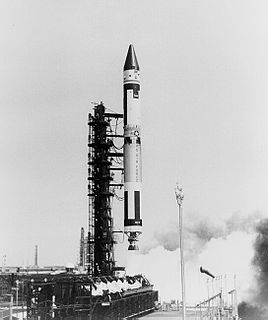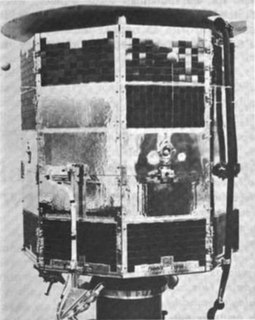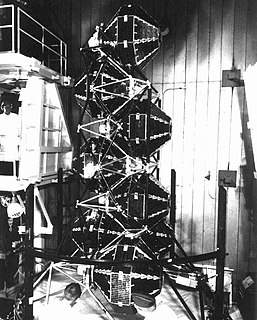
Titan was a family of United States expendable rockets used between 1959 and 2005. The Titan I and Titan II were part of the US Air Force's intercontinental ballistic missile fleet until 1987. The space launch vehicle versions contributed the majority of the 368 Titan launches, including all the Project Gemini crewed flights of the mid-1960s. Titan vehicles were also used to lift US military payloads as well as civilian agency reconnaissance satellites and to send interplanetary scientific probes throughout the Solar System.

The Titan IIIC was an expendable launch system used by the United States Air Force from 1965 until 1982. It was the first Titan booster to feature large solid rocket motors and was planned to be used as a launcher for the Dyna-Soar, though the spaceplane was cancelled before it could fly. The majority of the launcher's payloads were DoD satellites, for military communications and early warning, though one flight (ATS-6) was performed by NASA. The Titan IIIC was launched exclusively from Cape Canaveral while its sibling, the Titan IIID, was launched only from Vandenberg AFB.

The Titan IIIA or Titan 3A was an American expendable launch system, launched four times in 1964 and 1965, to test the Transtage upper stage which was intended for use on the larger Titan IIIC. The Transtage was mounted atop two core stages derived from the Titan II. The Titan IIIA was also used as the core of the Titan IIIC.
Orbiting Vehicle or OV, originally designated SATAR, comprised five disparate series of standardized American satellites operated by the US Air Force, launched between 1965 and 1971. Forty seven satellites were built, of which forty three were launched and thirty seven reached orbit. With the exception of the OV3 series and OV4-3, they were launched as secondary payloads, using excess space on other missions.

OPS 0855, also designated OV4-3, was an American boilerplate Manned Orbiting Laboratory spacecraft launched in 1966. It was flown to demonstrate the launch configuration for future MOL missions. A number of research payloads, designated Manifold, were carried on board, which were intended to operate for 75 days. However, the spacecraft ceased operations after just 30. It was built from a decommissioned HGM-25A Titan I first stage oxidizer tank, bolted to a Transtage. It was part of the MOL and Orbiting Vehicle projects.

The 6555th Aerospace Test Group is an inactive United States Air Force unit. It was last assigned to the Eastern Space and Missile Center and stationed at Patrick Air Force Base, Florida. It was inactivated on 1 October 1990.

Artemis 1 is a planned uncrewed test flight for NASA's Artemis program that is the first integrated flight of the agency's Orion MPCV and Space Launch System heavy-lift rocket. It is expected to launch on 4 November 2021.

OSCAR IV was the fourth amateur radio satellite launched by Project OSCAR and the first targeted for Geostationary orbit on 12 December 1965. The satellite was launched piggyback with three United States Air Force satellites on a Titan IIIC launch vehicle. Due to a booster failure, OSCAR 4 was placed in an unplanned and largely unusable Geostationary transfer orbit; however, OSCAR 4 did facilitate the first direct satellite communication between the United States and the USSR.

Orbiting Vehicle 2-1, the first satellite of the second series of the United States Air Force's Orbiting Vehicle program, was an American life science research satellite. Its purpose was to determine the extent of the threat posed to astronauts by the Van Allen radiation belts. Launched 15 October 1965, the mission resulted in failure when the upper stage of OV2-1's Titan IIIC booster broke up.

Orbiting Vehicle 1-1, was the first satellite in the OV1 series of the United States Air Force's Orbiting Vehicle program. OV1-1 was an American Earth science research satellite designed to measure radiation, micrometeoroid density, and magnetic fields in orbit. Launched 21 January 1965, the mission resulted in failure when, after a successful launch of its Atlas booster, OV1-1's onboard Altair motor failed to fire.

Orbiting Vehicle 1-3, was the second satellite in the OV1 series of the United States Air Force's Orbiting Vehicle program. OV1-3 was an American life science research satellite designed to measure the effects of orbital radiation on the human body. Launched 28 May 1965, the mission resulted in failure when its Atlas booster exploded two minutes after launch.

Orbiting Vehicle 1-2, launched 5 October 1965, was the third, and first successful, satellite in the OV1 series of the United States Air Force's Orbiting Vehicle program. A radiation measuring satellite designed to conduct research for the planned Manned Orbital Laboratory project, OV1-2 was the first American spacecraft to be placed into orbit on a western trajectory. The satellite stopped functioning in April 1967 after a series of technical problems starting two months after launch.

Lincoln Experimental Satellite 3, also known as LES-3, was a communications satellite, the third of nine in the Lincoln Experimental Satellite. Launched by the United States Air Force (USAF) on 21 Dec 1965, it was stranded in a Geostationary Transfer Orbit rather than its planned circular high orbit. Despite this, LES-3 returned good data on communications propagation in the UHF band.

Lincoln Experimental Satellite 4, also known as LES-4, was a communications satellite, the fourth of nine in the Lincoln Experimental Satellite, and the first of the series designed for operations at geosynchronous altitudes. Launched by the United States Air Force (USAF) on 21 December 1965, it demonstrated many then-advanced technologies including active use of the military's SHF band to service hundreds of users.

Orbiting Vehicle 1-4, launched 30 Mar 1966, was the fourth, and second successful, satellite in the OV1 series of the United States Air Force's Orbiting Vehicle program. OV1-4 was a long-term bioscience and materials science satellite, designed to return data relevant to long-term human presence in space. Its launch marked the first time two satellites were placed into orbit side-by-side with each other.

Orbiting Vehicle 1-5 was launched 30 Mar 1966, and was the fifth satellite in the OV1 series of the United States Air Force's Orbiting Vehicle program. OV1-5 conducted optical experiments, surveying the Earth in the infrared spectrum to see if water, land, mountains and deserts could be distinguished by their thermal gradients. It was launched concurrently with OV1-4 in the first ever side-by-side satellite orbital deployment.

Orbiting Vehicle 3-1, launched 22 April 1966, was the first satellite in the OV3 series of the United States Air Force's Orbiting Vehicle program. The satellite measured radiation above the Earth, returning useful data for over a year. It is still in orbit as of 1 April 2021.

The Initial Defense Communications Satellite Program or IDCSP was the first United States Department of Defense communications satellite constellation and the first stage of the Defense Communications Satellite Program (DCSP). Launched in five groups by Titan IIIC launch vehicles to near equatorial, subsynchronous orbits between 1966 and 1968, they were intended to be experimental testbeds. They were so successful that, by the time of the launch of the last set of eight satellites, the IDCSP was deemed operational and renamed Initial Defense Satellite Communications System or IDSCS. This system allowed real-time collection of battlefield intelligence during the Vietnam War. A total of 35 IDCSP satellites were launched, 27 successfully.

Orbiting Vehicle 3-4, launched 10 June 1966, was the second satellite to be launched in the OV3 series of the United States Air Force's Orbiting Vehicle program. The satellite measured radiation above the Earth, helping to determine the hazard posed to human spaceflight at typically traveled altitudes. OV3-4 is still in orbit as of 6 June 2021.

Orbiting Vehicle 2-5, the third and last satellite of the second series of the United States Air Force's Orbiting Vehicle program, was an American particle science and ionosphere research satellite. Launched 26 September 1968 along with three other satellites, OV2-5 became the first scientific satellite to operate at geosynchronous altitude.

















